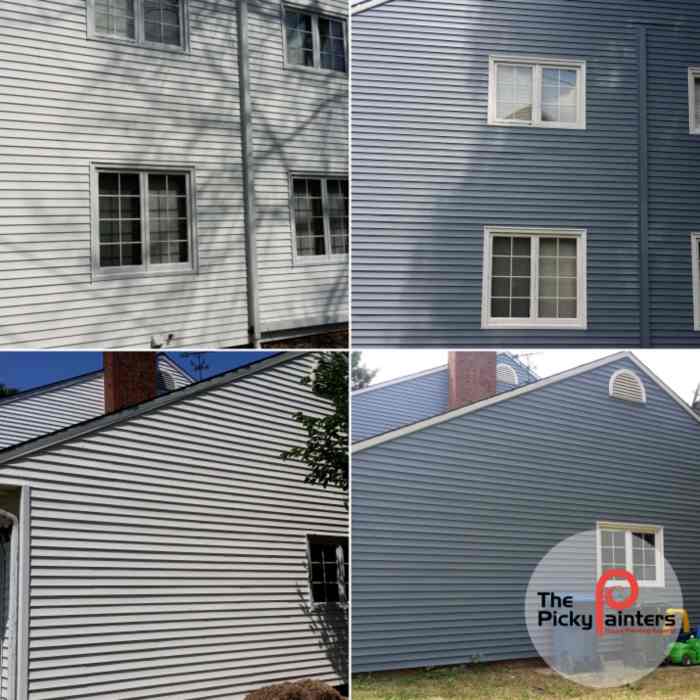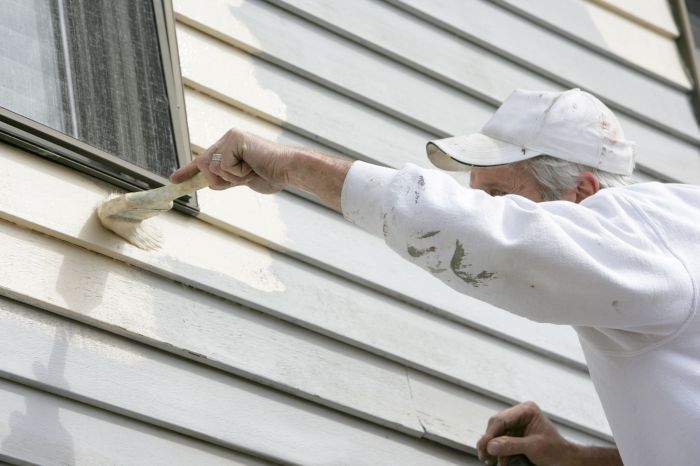Painting Vinyl House Siding: A Comprehensive Guide
Embark on a journey to transform your vinyl house siding with the art of painting. From preparation to maintenance, this guide will equip you with all the necessary knowledge to achieve a flawless finish.
Painting vinyl house siding can breathe new life into your home's exterior, adding curb appeal and protection. Let's dive into the world of painting vinyl siding and unleash your creativity.
Preparation for Painting Vinyl House Siding
Before painting vinyl house siding, it is crucial to properly clean and prepare the surface to ensure a smooth and long-lasting finish. Here is a step-by-step guide on how to prepare vinyl siding for painting, along with the importance of choosing the right paint for vinyl surfaces.
Cleaning the Siding
Before painting, thoroughly clean the vinyl siding to remove dirt, grime, and any mildew that may have accumulated over time. This step is essential to ensure proper adhesion of the paint and a smooth finish.
- Start by washing the siding with a mixture of water and mild detergent using a soft brush or sponge.
- Rinse the siding thoroughly with clean water to remove all soap residue.
- If there is mildew present, use a solution of one part bleach to four parts water to clean the affected areas.
- Allow the siding to dry completely before proceeding to the next step.
Choosing the Right Paint
When painting vinyl siding, it is important to select a paint that is specifically formulated for vinyl surfaces. Using the wrong type of paint can lead to peeling, cracking, and premature fading.
- Opt for a high-quality acrylic latex paint that is designed for exterior use on vinyl surfaces.
- Choose a paint color that is lighter than the original siding color to prevent warping or buckling due to heat absorption.
- Consider using a paint with built-in primer to ensure better adhesion and durability.
- Consult with a professional at your local paint store for recommendations on the best paint options for vinyl siding.
Painting Techniques for Vinyl House Siding

When it comes to painting vinyl house siding, there are various techniques that can help you achieve a professional finish. From applying paint evenly to choosing the right tools, here are some tips to consider:
Applying Paint Evenly on Vinyl Siding
- Start by cleaning the siding thoroughly to remove any dirt, debris, or mildew that could affect the paint adhesion.
- Use a high-quality exterior paint specifically designed for vinyl surfaces to ensure durability and longevity.
- Consider using a paint sprayer for a smooth and even application, ensuring that you maintain a consistent distance from the surface to avoid drips or uneven coverage.
- If using a brush, opt for one with synthetic bristles to prevent streaks and brush marks on the vinyl siding.
- Work in small sections and overlap each stroke slightly to blend the paint seamlessly.
Comparison of Painting Methods for Vinyl Surfaces
- Brush Painting: Offers precision and control, ideal for detailed areas and touch-ups but may result in brush marks on the smooth surface of vinyl siding.
- Sprayer Painting: Provides faster coverage and a more uniform finish, suitable for larger surface areas, but requires proper technique to avoid overspray.
- Roller Painting: Offers a balance between speed and control, suitable for flat surfaces, but may not reach into crevices or textured areas effectively.
Benefits of Using a Sprayer versus a Brush for Painting Vinyl Siding
- A paint sprayer can cover large areas quickly, saving time and effort compared to a brush.
- Sprayers can provide a more even coat of paint on the smooth surface of vinyl siding, reducing the likelihood of brush marks or uneven coverage.
- Brushes are more suitable for detailed work and touch-ups, allowing for precise application in hard-to-reach areas or corners.
- Ultimately, the choice between a sprayer and a brush depends on the size of the project, desired finish, and personal preference of the painter.
Maintenance and Longevity of Painted Vinyl Siding
Once you have successfully painted your vinyl siding, it is important to perform regular maintenance to ensure the longevity of the paint job. By following proper maintenance steps, you can preserve the painted finish and protect your siding from premature wear and tear.
Maintenance Steps for Painted Vinyl Siding
- Regularly clean the siding with a mild detergent and water to remove dirt, dust, and grime that can accumulate over time. Avoid using harsh chemicals or abrasive cleaners that can damage the paint.
- Inspect the siding annually for any signs of peeling, cracking, or chipping paint. Address any issues promptly by repainting the affected areas to prevent further damage.
- Trim overhanging trees and shrubs to prevent branches from scratching or damaging the painted surface of the siding.
- Avoid placing grills or other heat sources too close to the siding, as excessive heat can cause the paint to bubble or peel.
Ensuring Longevity of Painted Vinyl Siding
- Choose high-quality exterior paint specifically designed for vinyl siding to ensure durability and longevity.
- Apply the paint following the manufacturer's instructions and recommendations for optimal adhesion and long-lasting finish.
- Consider applying a clear coat or sealant over the paint to provide an extra layer of protection against UV rays, moisture, and other elements that can degrade the paint over time.
- Regularly inspect the siding for any signs of wear and tear, and perform touch-ups or repainting as needed to maintain the appearance and integrity of the paint job.
Repainting Frequency and Factors Affecting Durability
- The frequency of repainting vinyl siding can vary depending on factors such as climate, exposure to sunlight, and the quality of the original paint job.
- Generally, vinyl siding may need to be repainted every 5-10 years to maintain a fresh and vibrant appearance.
- Proper maintenance, including regular cleaning and inspections, can help extend the lifespan of the painted finish and reduce the need for frequent repainting.
- Factors such as extreme temperatures, moisture, and harsh weather conditions can affect the durability of the paint job, so it is important to address any issues promptly to prevent further damage.
End of Discussion

As we conclude this guide on painting vinyl house siding, remember that a well-painted exterior not only enhances the aesthetics of your home but also protects it from the elements. With the right techniques and maintenance, your painted vinyl siding can stand the test of time, showcasing your personal style for years to come.
Essential FAQs
How important is cleaning the siding before painting?
Cleaning the siding is crucial as it ensures proper adhesion of the paint and a smooth finish.
What are the benefits of using a sprayer versus a brush for painting vinyl siding?
A sprayer can provide a more even coat and faster application, while a brush allows for better precision in detail work.
How often should vinyl siding be repainted?
The frequency of repainting depends on factors like climate and sun exposure, but typically every 5-7 years is recommended.




